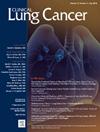A Phase II, Open Label, Single-Arm Study on the Efficacy of Cabozantinib in Patients With Advanced/Metastatic Nonsmall Cell Lung Cancer Harboring MET Exon 14 Alterations who Developed Acquired Resistance to Tepotinib or Capmatinib (CAPTURE Trial)
IF 3.3
3区 医学
Q2 ONCOLOGY
引用次数: 0
Abstract
Background
MET gene exon 14 skipping was identified as a potential driver mutation that occurs in approximately 3%-4% of patients with nonsmall cell lung cancer (NSCLC), typically in the absence of other driver mutations. Capmatinib and tepotinib were the first MET- tyrosine kinase inhibitors (MET-TKIs) approved by the FDA and PMDA, specifically for patients with metastatic NSCLC. Several studies have reported acquired resistance after MET-TKI treatment for MET mutation-positive NSCLC. Sequencing of the MET kinase region of resistant cell lines revealed secondary mutations at residues D1228 and Y1230 that were sensitive to type II MET-TKIs, such as cabozantinib. This suggested that sequential administration of other MET-TKIs may overcome the development of secondary mutations after acquired resistance in MET exon 14 mutation-positive NSCLC.
Methods
We designed the single arm phase II study CAPTURE Trial to assess the efficacy of cabozantinib in patients with advanced/metastatic NSCLC with activating MET exon 14 alterations who developed acquired resistance to tepotinib or capmatinib, as well as after 2 prior chemotherapy regimens that included platinum and docetaxel. The primary endpoint was objective response rate by independent review committees. The sample size (n = 30) is calculated by assuming a threshold response rate of 5% and an expected response rate of 25%. Recruitment began in August 2024.
Results
This ongoing study aimed to evaluate the safety and efficacy of cabozantinib after acquired resistance to tepotinib or capmatinib.
一项关于Cabozantinib在晚期/转移性非小细胞肺癌患者中的疗效的II期,开放标签,单臂研究,这些患者携带MET外显子14改变,对替波替尼或卡马替尼产生获得性耐药(CAPTURE试验)。
背景:MET基因外显子14跳变被认为是一种潜在的驱动突变,发生在约3%-4%的非小细胞肺癌(NSCLC)患者中,通常在没有其他驱动突变的情况下。卡马替尼和替波替尼是首批获得FDA和PMDA批准的MET-酪氨酸激酶抑制剂(MET- tkis),专门用于转移性NSCLC患者。一些研究报道MET突变阳性NSCLC在MET- tki治疗后获得性耐药。对耐药细胞系MET激酶区域的测序显示,对II型MET- tkis(如cabozantinib)敏感的残基D1228和Y1230发生了继发性突变。这表明,在MET外显子14突变阳性的NSCLC中,序贯给药其他MET- tkis可能克服获得性耐药后继发性突变的发展。方法:我们设计了单臂II期研究CAPTURE试验,以评估cabozantinib对晚期/转移性NSCLC患者的疗效,这些患者具有活化的MET外显子14改变,对替波替尼或卡马替尼产生获得性耐药,以及之前接受过2种化疗方案,包括铂和多西他赛。主要终点是独立审查委员会的客观缓解率。样本量(n = 30)是通过假设阈值回复率为5%和预期回复率为25%来计算的。招聘于2024年8月开始。结果:这项正在进行的研究旨在评估对替波替尼或卡马替尼获得性耐药后卡博赞替尼的安全性和有效性。
本文章由计算机程序翻译,如有差异,请以英文原文为准。
求助全文
约1分钟内获得全文
求助全文
来源期刊

Clinical lung cancer
医学-肿瘤学
CiteScore
7.00
自引率
2.80%
发文量
159
审稿时长
24 days
期刊介绍:
Clinical Lung Cancer is a peer-reviewed bimonthly journal that publishes original articles describing various aspects of clinical and translational research of lung cancer. Clinical Lung Cancer is devoted to articles on detection, diagnosis, prevention, and treatment of lung cancer. The main emphasis is on recent scientific developments in all areas related to lung cancer. Specific areas of interest include clinical research and mechanistic approaches; drug sensitivity and resistance; gene and antisense therapy; pathology, markers, and prognostic indicators; chemoprevention strategies; multimodality therapy; and integration of various approaches.
 求助内容:
求助内容: 应助结果提醒方式:
应助结果提醒方式:


